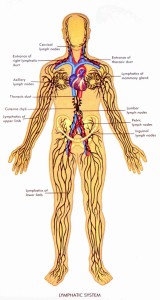 The lymphatic system is part of the circulatory system. It is a secondary pathway to the heart, parallel to the venous system. It moves fluids through the body and returns it to the circulatory system. The lymphatic circulation has a slow rhythm, as compared to blood circulation. The lymphatic system is the body’s waste disposal. It clears away bacteria, cell debris, excess water, proteins and wastes from the connective tissue and returns it to the bloodstream for ultimate removal by the kidneys. Lymph drainage massage increases lymphatic circulation and helps detoxify the body. It drains sluggish lymph nodes. The purpose of lymphatic drainage is to cleanse and regenerate tissues and organs, and to promote balance of chemistry. It stimulates the movement of lymph and encourages the formation of lymphocytes that produce antibodies, increasing the body’s resistance to infection. If tissue has been damaged, Lymphatic drainage helps to stimulate the lymphatic system to remove wastes more rapidly from around these inflamed tissues sending it back to the lymphatic system for removal and cleansing. Manual Lymphatic Drainage is safe and indicated for most people with a few notable exceptions. If you are frequently ill or just sluggish, MLD can help overcome this burden if the primary cause is an overtaxed lymphatic system. Minor edemas can be helped with basic lymphatic techniques. The lymphatic flow can stagnate for many reasons, such as swelling, chronic inflammation, lack of physical activity, stress, fatigue, emotional shock, age, poorly fitted brassieres, or brassieres worn for an excessive amount of time. When lymphatic circulation slows down, the regeneration of cells becomes less effective. This condition allows toxins and proteins to accumulate around the cells, causing cellular oxygenation to decrease and tissue regeneration to diminish.
The lymphatic system is part of the circulatory system. It is a secondary pathway to the heart, parallel to the venous system. It moves fluids through the body and returns it to the circulatory system. The lymphatic circulation has a slow rhythm, as compared to blood circulation. The lymphatic system is the body’s waste disposal. It clears away bacteria, cell debris, excess water, proteins and wastes from the connective tissue and returns it to the bloodstream for ultimate removal by the kidneys. Lymph drainage massage increases lymphatic circulation and helps detoxify the body. It drains sluggish lymph nodes. The purpose of lymphatic drainage is to cleanse and regenerate tissues and organs, and to promote balance of chemistry. It stimulates the movement of lymph and encourages the formation of lymphocytes that produce antibodies, increasing the body’s resistance to infection. If tissue has been damaged, Lymphatic drainage helps to stimulate the lymphatic system to remove wastes more rapidly from around these inflamed tissues sending it back to the lymphatic system for removal and cleansing. Manual Lymphatic Drainage is safe and indicated for most people with a few notable exceptions. If you are frequently ill or just sluggish, MLD can help overcome this burden if the primary cause is an overtaxed lymphatic system. Minor edemas can be helped with basic lymphatic techniques. The lymphatic flow can stagnate for many reasons, such as swelling, chronic inflammation, lack of physical activity, stress, fatigue, emotional shock, age, poorly fitted brassieres, or brassieres worn for an excessive amount of time. When lymphatic circulation slows down, the regeneration of cells becomes less effective. This condition allows toxins and proteins to accumulate around the cells, causing cellular oxygenation to decrease and tissue regeneration to diminish. As an advanced practitioner of Lymph Drainage Therapy I’m trained to interact with the fluids at different levels, from the superficial cutaneous circulation to the mucosa, muscles, tendons, periosteum and viscera. We also perform Manual Lymphatic Mapping to assess the direction of lymph flow before, during and after treatment to see if the location of lymph stagnation has improved.
No comments:
Post a Comment